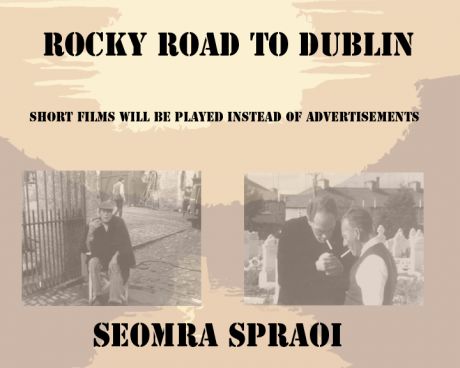Thursday January 01 1970
Rocky Road To Dublin - Screening
 dublin |
arts and media |
event notice
dublin |
arts and media |
event notice  Friday July 27, 2007 17:45
Friday July 27, 2007 17:45 by seomra spraoi screening working group
by seomra spraoi screening working group screeninggroup at hushmail dot com
screeninggroup at hushmail dot com
Suggested Donation: Waged/Unwaged 2.50 /2.00
Directions:
Coming from Capel St bridge, turn left at the Boar's Head off Capel Street, large grey-blue building on your right, old Melody Maker building. It is across the road from the "Capel Building" and Rhodes restaurant. It is on the Luas track.
time 7:30
If you want to screen a feature/short/documentary/music video..........
screeninggroup@hushmail.com
Short films will be screening as well. (Subtitles used when ever possible).
Rocky Road To Dublin
A young Paris-based Irish journalist, Peter Lennon, had long been disenchanted with the Irish society that evolved after independence in 1921, believing it to have been a revolution that essentially failed to live up to its idealistic origins as it became hijacked by more reactionary forces . These elements then conspired to build a society that was, he feels, in many ways as restrictive as the one which it replaced. Lennon, who left Ireland in the late '50's, believing it to be "a country with its future in the hands of people who think in terms of the past" wished to debate this question with a wider audience.
Shot on location in Dublin by Raul Coutard, who was at the time one of the world's best cinematographers, having worked with Truffaut and on all of Godard's early films, the film's commentary, written by Lennon himself, set the agenda clearly; "This is an attempt to reconstruct in images the plight of an island community which survived nearly 700 years of English occupation and then nearly sank under the weight of its own heroes -and clergy". The central question posed is simply, "What do you do with your revolution once you've got it?" The film, over the next 70 minutes, attempts to answer this dilemma, which is an organic part of the problems that face any revolution, once the initial period of dramatic change has taken place.
It opens with Coutards hand-held camera moving through the streets of Dublin with the Dubliners version of the title-song playing over the soundtrack. This gives it the same kind of rolling energetic feel that made French new wave cinema such a major influence at this time. It moves quickly into a series of interviews with the intellectual and social hierarchy of 60's Ireland who speak with an honesty and a directness that still appears fresh today.
After years of battling against the forces of the establishment that he so despised, Peter Lennon had by 1968, clearly taken its toll as he disgustedly dissects post-independent Ireland. As an example of the rhetoric of disgust it is worth quoting in full. "It was a society of what I would call urbanised peasants. A society without real moral courage, constantly observing a self-interested silence, never speaking in moments of crisis and in constant alliance with a completely obscurantist, repressive, regressive and uncultivated church. I often feel that if those dead men of 1916, before the bullets crashed into their heads and before the rope tightened around their necks, had seen the kind of reward that would come out of their sacrifice, they would have felt only that their efforts had been betrayed and that their sacrifice had been in vain."
Lennon's next target was the Church and particularly their hold on education, believing that "the strongest weapon they have is not the law but the way you are conditioned in childhood to be ashamed". An eight year old boy is shown obediently discussing the effects of original sin which result in us being made "less brainier which means that doctors have not yet found cures for certain diseases." Also there would have been "no stupid people which would mean that the poor would be very rich." A companion adds that wearing "very mini-skirts" is a chief danger to chastity.
The film painted a very unflattering picture of Ireland at a time when people were becoming materially better off than they ever were before. This portrayal of them as being complacent, obsequious down-trodden victims of a censorious, priest-ridden society of self-serving politicians did not sit well in many quarters. Lennon was accused of being a communist on 'The Late Late Show,' of being "anti-everything" by 'The Evening Herald' and Alf McLochhlan, a film society critic opined that he was "one of those sincere guys who make very bad films" and that this one could be "classed as for the blind."
This was exactly the kind of response that Lennon wanted to his private showing of the film in Dublin in early 1968. The more condemnation and comment the better because that made it less likely to be banned. "The idea was to whip up a scandal and get out before the film was seized thus creating a force more powerful than censorship - curiosity," said Lennon, who insisted that the film was made primarily to be seen by the Irish people. There was some positive critical comment, especially from writers such as Fergus Linehan,who repeatedly defended the film, believing that it was a welcome break from the glossy Bord Failte view of Ireland and one that "owed nothing to any establishment ideas about how this country should be projected."
The Rocky Road to Dublin was the only film that Lennon ever made. It had a limited run in Dublin but it never received a provincial release. It has never been broadcast on television. RTE apparently believing it to be too contentious for domestic consumption in the 1960's, '70's or even '80's.
http://www.irishmeninparis.org/framesets/peter%20lennon.htm
http://www.opendemocracy.net/arts-Film/ireland_church_2...9.jsp
http://www.indymedia.ie/article/72811
http://www.frif.com/new2005/dub2.html
